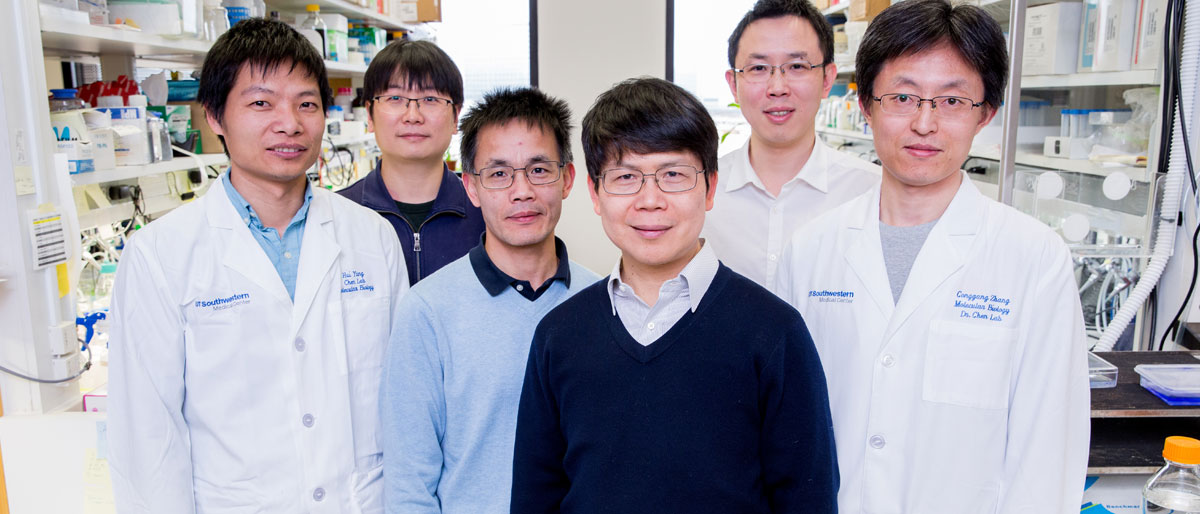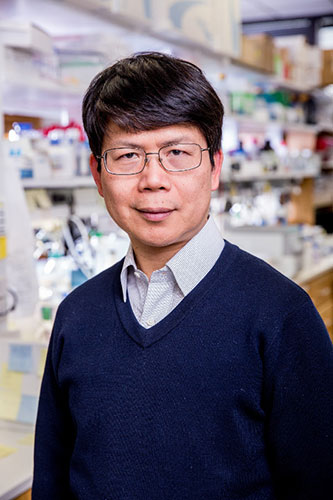UTSW researchers determine structures of elusive innate immunity protein

UT Southwestern researchers used cryo-electron microscopy (cryo-EM) to determine the near-atomic structure of the smallest membrane protein solved to date. Their work could lead to better immunotherapies in cancer and improved treatments for autoimmune diseases like lupus.
Cryo-EM – the technology credited with the “resolution revolution” underway in structural biology – uses a massive microscope to shoot a narrow stream of electrons through thin, flash-frozen samples. The STING (Stimulator of Interferon Genes) protein studied in UT Southwestern’s 24/7 Cryo-Electron Microscopy Facility is about half the size of the next-smallest membrane protein determined, the researchers said.

UT Southwestern’s Dr. Zhijian “James” Chen is a corresponding author on three studies published online recently by Nature that describe this work. Two studies reveal the first full-length structure of the elusive STING protein attached to different molecules in the pathway. STING is a key member of an important pathway in innate immunity – the body’s first line of defense against infections. The third study gives insight into the primitive function of the cGAS-STING pathway and underscores the importance of understanding its protein structure.
Having the structure of the full-length STING protein at near-atomic resolution is very important for understanding innate immunity. It is also important for developing drugs that activate STING for cancer immunotherapy or inhibit the protein for treatment of autoimmune diseases, like lupus and arthritis,
said Dr. Chen, Director of the Center for Inflammation Research, Professor of Molecular Biology, and a Howard Hughes Medical Institute Investigator at UT Southwestern.
This animation shows the atomic details of the interaction between the STING tail (yellow) and TBK1 (blue and cyan).
Credit: Conggang Zhang, Guijun Shang and Nature
In November, Dr. Chen was awarded the $3 million 2019 Breakthrough Prize in Life Sciences – one of the world’s most prestigious biomedical awards – for his discovery of the cGAS enzyme. That DNA sensor launches the body’s immune defense against infections and cancers in a pathway in which the STING protein is pivotal. The cGAS enzyme patrols the cell’s interior and triggers an immune response when it encounters foreign DNA. It can also trigger autoimmunity when it finds self-DNA in areas of the cell where that genetic material should not exist. cGAS produces a small molecule called cGAMP (cyclic GMP-AMP), which binds to STING and launches an immune response.
This animation shows how STING switches from the inactive state to the cGAMP-bound active state, through a half-turn rotation.
Credit: Guijun Shang, Conggang Zhang and Nature
The cGAS-cGAMP-STING pathway leads to interferon production in mammals in response to DNA invasion,
Dr. Chen said. Interferons – signaling proteins – tell cells to heighten their defenses against foreign invaders.
One of the two structural studies reports the first structure of STING in complex with TBK1 (Tank-Binding Kinase 1), the molecule that activates it and leads to production of specific interferons and other signaling molecules. The experiments, which used both human and chicken STING proteins, also reveal the tail end of STING, which was invisible in previous structures.
That tail is lacking in STING from sea anemones, the subject of Dr. Chen’s third paper. Sea anemones are part of a group of invertebrates (creatures that lack a backbone) thought to exist for hundreds of millions of years before the first humans did. That study finds that STING in sea anemones can activate an immune response through autophagy. Often called cellular housekeeping, autophagy clears away unwanted molecules – in this case pathogens – within the cell by breaking them down for recycling. Humans have the c-GAS-STING-to-autophagy immune pathway as well as the c-GAS-STING-to-interferon pathway that sea anemones lack.
That finding led Dr. Chen to suggest that, as in a scorpion, the “STING is in the tail.” More seriously, he said the study suggests that autophagy is a primordial (primitive) pathway for immunity that developed earlier than the interferon pathway found in humans.
STING is by far the smallest membrane protein that has been solved to near-atomic resolution using cryo-EM,
said Dr. Xiaochen Bai, a co-corresponding author of the two STING structure papers. Dr. Bai is an Assistant Professor of Biophysics and Cell Biology. The third corresponding author is Dr. Xuewu Zhang, Associate Professor of Pharmacology and Biophysics.
Lead authors of the structural STING studies are postdoctoral researchers Drs. Guijun Shang (Pharmacology) and Conggang Zhang (Molecular Biology). The lead authors of the autophagy study are former graduate student Dr. Xiang Gui and Dr. Hui Yang, a postdoctoral researcher in the Chen laboratory.
The studies received funding from the Cancer Prevention and Research Institute of Texas (CPRIT), the Howard Hughes Medical Institute, the National Institutes of Health, The Welch Foundation, and the UT Southwestern Endowed Scholars Program.
Dr. Bai and Dr. Zhang are both Virginia Murchison Linthicum Scholars in Medical Research.
Dr. Chen holds the George L. MacGregor Distinguished Chair in Biomedical Science.

